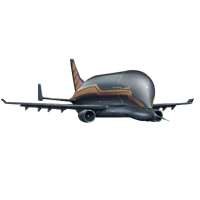Blohm & Voss
BV 238 flying boat
 |
|
| The prototype BV 238 V1 in June 1944 | |
| Role | Flying boat |
|---|---|
| National origin | Nazi Germany |
| Manufacturer | Blohm & Voss |
| First flight | April 1944 |
| Status | Retired |
| Primary user | Luftwaffe |
| Number built | 1 (with 2 incomplete prototypes)[ |
.
History Hamburger Flugzeugbau
Blohm & Voss BV 238 flying boat
First flight April 1944
Status Retired

The Blohm & Voss BV 238 was a German flying boat, built during World War II. It was the heaviest aircraft ever built when it first flew in 1944, and was the largest aircraft produced by any of the Axis powers during World War II.
Development of the BV 238 giant flying boat began in 1941, following the success of the smaller but still enormous BV 222 Wiking.
An approximately quarter-scale model of the BV 238 was commissioned to test the new, long and slim hull design. Built by the Czechoslovakian Flugtechnische Fertigungsgemeinschaft Prag (FGP), the FGP 227 arrived too late to contribute any data to the program.
Variants

The BV 238 was an extremely large flying boat of conventional aerodynamic design, but bearing the usual B&V structural hallmarks of all-metal construction with a tubular steel wing main spar which also acted as the armoured main fuel tank. Of the era, only the earlier Tupolev ANT-20, the Martin XPB2M-1 and the later Hughes H-4 had a bigger wing span. However it would be the heaviest yet flown, at 100 tonnes (220,000 lb) fully loaded.
The hull had an unusually long and slim planing bottom, of essentially two-step design but with a row of smaller auxiliary steps behind the main one. A large nose door opened onto its cavernous interior, with the main crew cabin immediately above and behind it.
The wing was of straight, constant-chord form with tapered outer sections. Auxiliary floats were integrated into underside panels of the outer sections and could be retracted to lie flush with the wing. A catwalk ran internally along the wing in front of the tubular steel main spar, providing access to the engines in flight.
Power was provided by six 1,287 kW (1,750 hp) Daimler-Benz DB 603 liquid-cooled inverted V12 piston engines, arranged in nacelles along the leading edge of the centre section.
0
KmCeiling
0
KmCombat RANGE
0
Km/hAircraft Speed
0
Max Crew
Photo Gallery
Hamburger Flugzeugbau
Blohm & Voss BV 238 flying boat


HFB-Flugzeugbau GmbH
Blohm & Voss BV 238 flying boat
General Info
-
-
- Crew: 12
- Length: 43.35 m (142 ft 3 in)
- Wingspan: 60.17 m (197 ft 5 in)
- Height: 12.8 m (42 ft 0 in)
- Wing area: 360.16 m2
-
Powerplant
-
- Empty weight: 54,780 kg
- Gross weight: 90,000 kg for reconnaissance missions
-
-
-
-
-
- 95,000 kg for bomber missions
-
-
-
-
- Max takeoff weight: 100,000 kg
- Powerplant: 6 × Daimler-Benz DB 603G inverted V-12 liquid-cooled piston engines, 1,417 kW (1,900 hp) each for take-off 1,163 kW (1,560 hp) at 7,375 m (24,196 ft)
- Propellers: 3-bladed constant-speed propellers
-
Performance
- Maximum speed: 183 km/h
- Maximum speed: 350 km/h at 60,000 kg weight at sea level
-
-
-
-
-
-
- 425 km/h at 60,000 kg
-
-
-
-
-
- Landing speed: 143 km/h
- Range: 6,620 km at 365 km/h at 92,000 kg at 2,000 m
- Service ceiling: 7,300 m
Links to Youtube & Others
A landplane version, initially called the BV 238-Land, was proposed, capable of carrying out transport, long-range bombing and transatlantic reconnaissance duties.
Blohm & Voss
BV 238 flying boat
The Blohm & Voss BV 238 was a German flying boat, built during World War II. It was the heaviest aircraft ever built when it first flew in 1944.
Youtube Link
The wing was of straight, constant-chord form with tapered outer sections. Auxiliary floats were integrated into underside panels of the outer sections and could be retracted to lie flush with the wing












